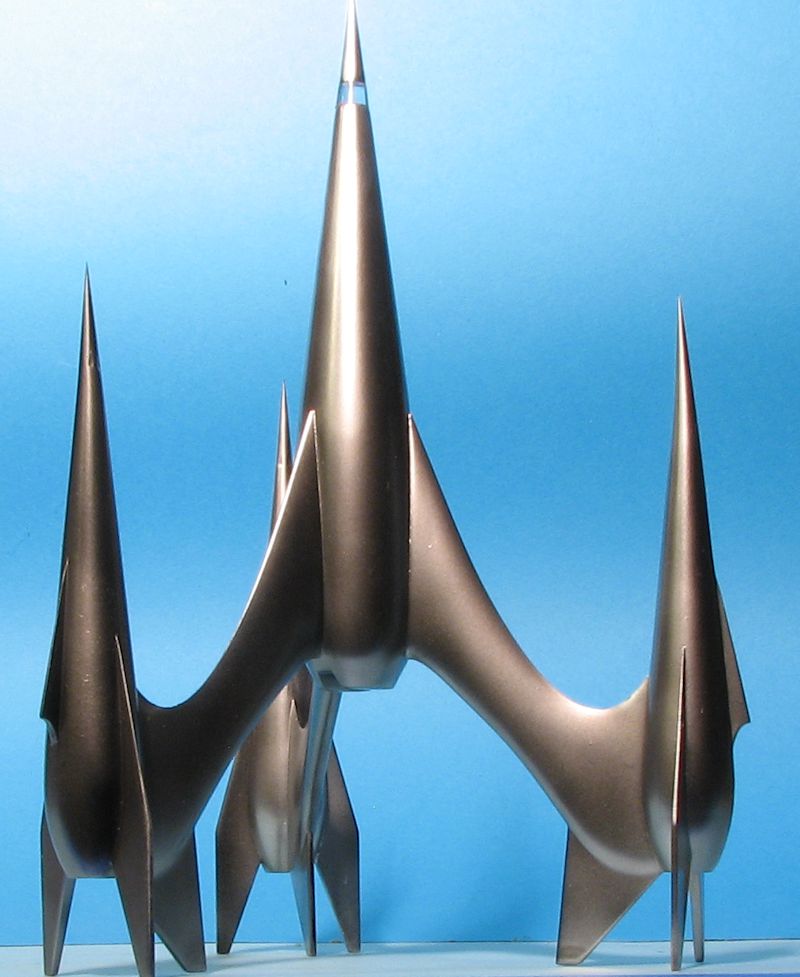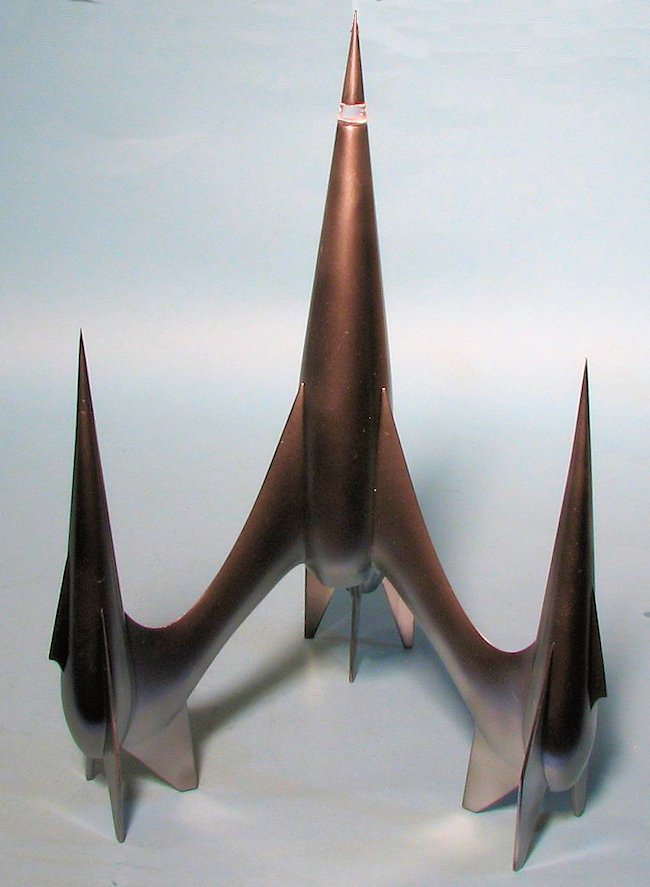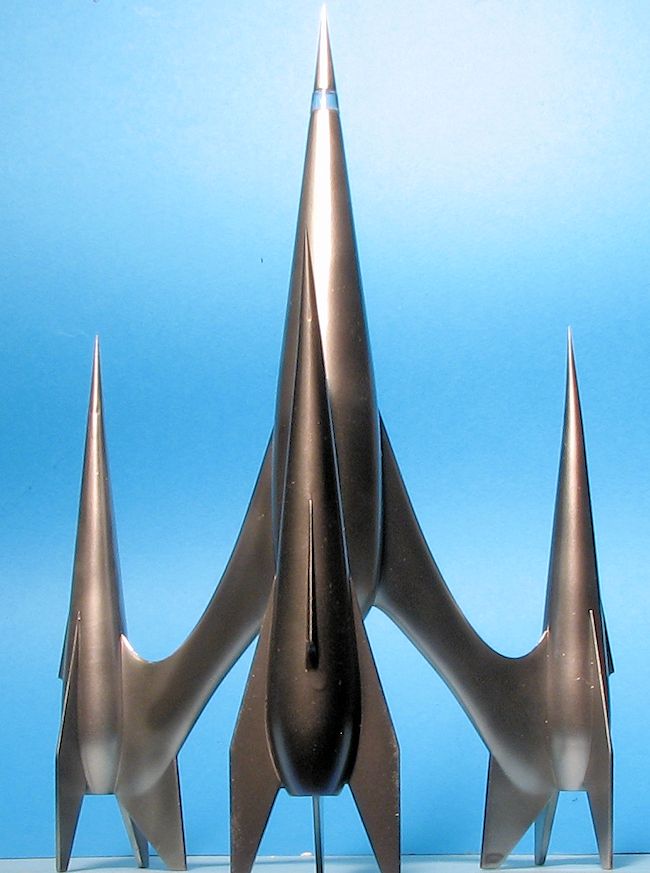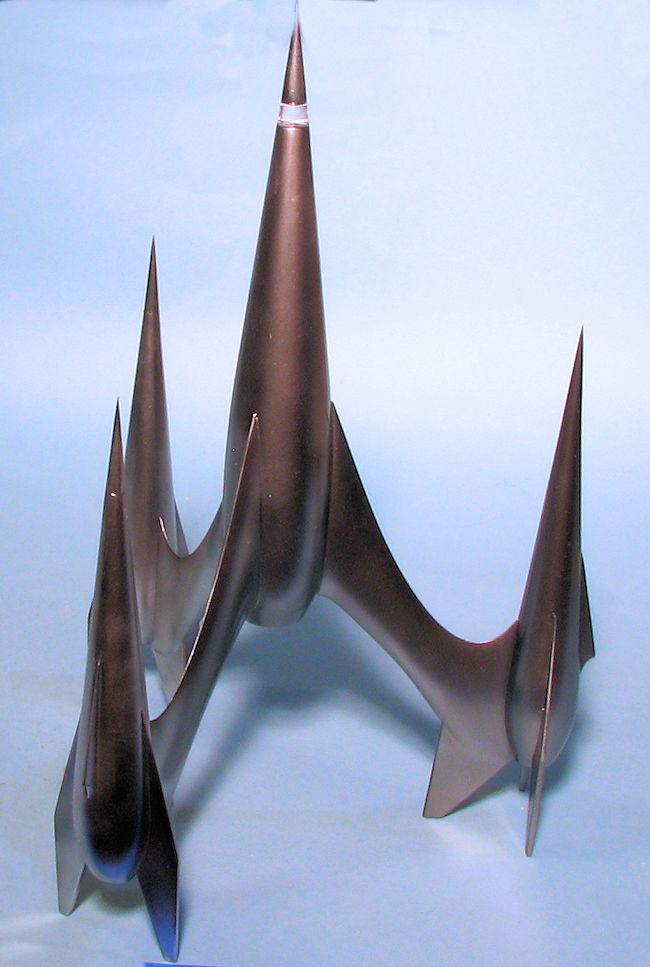
| KIT #: | 9114 |
| PRICE: | $27.95 SRP |
| DECALS: | None |
| REVIEWER: | Scott Van Aken |
| NOTES: | 23 parts |

| HISTORY |
First Spaceship on Venus, German: Der schweigende Stern (en: The Silent Star), Polish: Milcząca Gwiazda, is a 1960 East German/Polish science fiction film directed by Kurt Maetzig and based on the novel The Astronauts by Stanisław Lem.
Spoiler alert: Film description starts below.
The film begins in 1985, when engineers involved in an industrial project to
irrigate the Gobi Desert accidentally unearth a mysterious and apparently
artificial "spool." When found to be made of a material unknown on Earth, the
spool is circumstantially linked to the Tunguska explosion of 1908. The "spool"
is seized on as evidence that the explosion, originally blamed on a meteor, was
actually caused by a spaceship. Professor Harringway deduces the alien craft
must have come from Venus. The spool itself is determined to be a flight
recorder, and partially decoded by an international team of scientists led by
Professor Sikarna and Dr. Tchen Yu. When radio greetings sent to Venus go
unanswered, Harringway announces that a journey to Venus is Earth's only
alternative. The recently completed Soviet spaceshipCosmostrator I (Kosmokrator in
the original), intended to voyage to Mars, is redirected to Venus, a 30–31 day
trip. During the voyage, Sikar na works furiously to translate the alien message
on the disc using the ship's computer.
na works furiously to translate the alien message
on the disc using the ship's computer.
When the ship nears Venus, radio interference from that planet cuts the crew off from Earth. By then, Sikarna's efforts lead to a stunning discovery—the spool describes a Venusian plan to irradiate the Earth's surface, with the extermination of mankind being the prelude to an invasion. Rather than a "cosmic document" as had been expected, the spool bears a cold-blooded message of destruction. Harringway convinces the crew to press on towards Venus rather than return to Earth with news that would cause panic.
With the ship's robot Omega, American astronaut Brinkman pilots a one-man landing craft. On the ground, he encounters an industrial complex and finds small recording devices that look like insects. The rest of the crew follow when Cosmostrator lands, but find no Venusian life forms. Journeying across the planet, they find the remains of a deserted and blasted city centered around a huge crater—signs of a catastrophic explosion so intense, shadowy forms of humanoid Venusians are permanently burned into the walls of surviving buildings.
While the Venusians are gone, their machines remain functioning, including the radiation-bombardment machine intended for Earth. One of the scientists accidentally triggers the radiation weapon leading to a frantic effort by the Earthmen to disarm it. Tchen Yu lowers Talua—the ship's communication officer—into the Venusian command center. When Tchen Yu's suit is punctured, Brinkman goes out to save him. Before he can reach Yu, Talua succeeds in reversing the radiation weapon. Unfortunately, this reverses the planet's gravitational field, flinging Cosmostrator into space. Brinkman is also repelled off the planet, beyond reach by Cosmostrator, while Talua and Tchen Yu remain marooned on Venus. The surviving crew members return home, where they warn the people of Earth about the danger of atomic weapons.
Despite what sounds like an interesting movie, it is one of those that is often paired with other winners on the 2for$5 racks in video stores on shops. One if its saving graces is that it shows some clear images of some main characters arriving at the launching site in a very shiny MiG-15bis. It also has the usual attempt at a loveable robot and has a very cosmopolitan crew, made up of mostly those from socialist nations.
| THE KIT |
 To many of us who watch old sci-fi, like this 1960 release,
the space ship is often a focal point of our interest. In this case, the space
ship is called, unsurprisingly, the Cosmostrator. The design is rather striking
and is such that was not normally seen in similar movies produced in Hollywood
at the time. It consists of a three 'winged' ship with very spikey engine
nacelles at the end of each of the scimitar shaped wings. The central housing is
also quite pointy and has a clear full vision area near the tip that houses a
searchlight for peering through the gloom.
To many of us who watch old sci-fi, like this 1960 release,
the space ship is often a focal point of our interest. In this case, the space
ship is called, unsurprisingly, the Cosmostrator. The design is rather striking
and is such that was not normally seen in similar movies produced in Hollywood
at the time. It consists of a three 'winged' ship with very spikey engine
nacelles at the end of each of the scimitar shaped wings. The central housing is
also quite pointy and has a clear full vision area near the tip that houses a
searchlight for peering through the gloom.
As Pegasus kits go, this one has a lot of parts. There are three identical sprues for each of the wings and accompanying power pods. The central fuselage is in two pieces, topped by the lone clear bit, which looks as if it was ripped from the sprue by the Chinese factory workers, and another pointy bit. Though the instructions imply that this clear bit should be able to turn, my copy was missing the hold back piece on the bottom of it. The instructions also show that the main fuselage should have a slit nozzle piece to attach to the bottom, but this has been molded into the fuselage halves, leaving a seam that will be quite challenging to fill.
Each of the wing nacelles has the one-piece main strut and half of the nacelle. The other half, two fins and the rocket nozzle make up each assembly.
Instructions are three steps with well done and clear drawings. There are no decals and the model is supposed to be painted a very shiny chrome.
| CONSTRUCTION |
First thing I notice was that the parts were all quite nicely
done with no flash or ejector pin marks. Even the main fuselage halves, which
were not on sprues, were cleanly done. The three sprues with the wings have a
very large sprue attachment point that needed cutters to remove.
cutters to remove.
I first glued the main fuselage halves together and then, after installing the very nicely fitting rocket nozzles, glued the wing pod halves. On all three, the pod seams near the nozzle were difficult to close all the way so had to have filler used once the glue dried.
With those done, the very pointy tips to the wing pods were added. These did not fit snugly and were also larger than the tips of the pod. Super glue filler and sanding took care of these issues. Once I made sure all the seams were filled on the pods (and due to the very shiny chrome scheme, it is imperative that there be no showing seams), I added the two additional fins per wing/pod. I then filled all the seams with Mr. Surfacer.
| COLORS & MARKINGS |
I first gave the kit an overall spray of Tamiya extra fine primer (grey). When dry I then sprayed the entire surface with Alclad II's gloss black primer. This stuff stays sticky for an age and was probably the reason I'd not used this stuff in many years. After a week, it was still a bit tacky but I went ahead and sprayed on several coats of Alclad II highly polished aluminum. Even after several days, the surface was still tacky and it did not coat as nicely as I would have hoped.
The last steps were to attach the upper nose clear piece, followed by the nose cone, and that was it.
| CONCLUSIONS |
This build only goes to show that what looks simple often is not quite as expected. The seams are relatively large on the fins, requiring filler. This is because the mating surface on the each inner fin is actually more of a shallow vee than flat, and even careful scraping and sanding will not get rid of it all. Despite that, it does make into a nice model that has been added to my small, but growing series of sci-fi movie and TV vehicles.
| REFERENCES |
http://en.wikipedia.org/wiki/first_spaceship_on_venus
May 2014
Thanks to me
for the review kit. If you would like your product reviewed fairly and
fairly quickly, please
contact
the editor or see other details in the
Note to
Contributors.